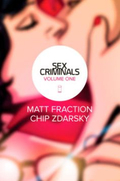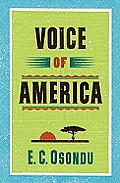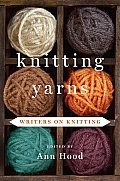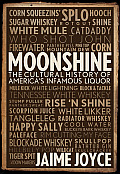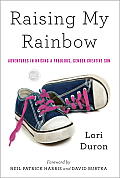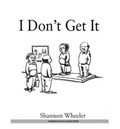Link to this review in the form of a comic strip by geneambaum tagged science fiction • graphic novel • erotica

Click for the full-sized comic
Contains Sex Criminals #1 - #5
Publisher’s Rating: M / Mature
@bookblurb A librarian and her boyfriend stop time when they have orgasms. They rob a bank to save the library.
Link to this review by wally tagged short stories
Eighteen stories by Nigerian author Osondu focused on the tension between Africans and Americans, traditional values and modernity, young and old, and rich and poor.
Why I picked it up: I haven’t read a book by an African author in a while.
Why I finished it: Osondu crafts beautiful tales that never ended the way I expected. In one, a girl blinded in a cooking accident develops a second sight that allows her to identify criminals, predict the weather, and bring prosperity to her village. When a charity organization visits to help those with sight-related problems, the village convinces her to hide until they leave. In another, an unemployed expat American oil worker is kidnapped by poor Nigerian youth hoping for a ransom. They cannot believe no one will pay anything for the guy. In the title story, a young man answers a radio call from an American looking for pen pals and strikes up a relationship with her in just three letters. Only later does he discover she is a high school student looking for help with a paper about Africans.
Readalikes: This book reminded me of Annie Proulx’s Close Range: Wyoming Stories because even though the setting is wildly different, both authors create believable, unpredictable characters.
@bookblurb Stories on the tension between Africans and Americans, traditional and modern values, young and old, rich and poor.
Link to this review by sarahhunt tagged essays • nonfiction
Ann Hood wrote the novel The Knitting Circle after taking up knitting to cope with the loss of her daughter. After that other writers told her knitting stories, and she felt they needed to be read. From people knitting through grief to people connecting by passing on the craft, the stories get to the real heart-deep reasons people knit.
Why I picked it up: My mom read the story about the guy who knit for his four pound Chihuahua, Clovis, and said it was hilarious.
Why I finished it: I found stories that reflected my own knitting history. One woman started for stress relief after her doctor threatened to put her on statins for her blood pressure. I started so that I could deal with grad school. Story after story told about people who knit to get through a crisis, everything from death, to divorce, to losing a friend to a cult. I’m in a knitting group for cancer survivors and caregivers that has been my lifeline through a lot of heavy stuff. Barbara Kingsolver’s gorgeous essay sums it all up perfectly: “Sometimes it starts terribly. With the injury or the accident or the wrecked life flung down like a loud armload of broken chair legs on your doorstep.”
It’s perfect for: Darcy, who saved my sanity by sending me the essay “The Sacrament of Divorce” from This Is The Story of a Happy Marriage by Ann Patchett, right when I was overwhelmed by practical and emotional baggage I needed to shed. In the book, Patchett also tells the story of being sent a knitting project that mended her heart after losing a friend.
@bookblurb Writers write about why they knit: stress relief, connecting with friends, grief, and getting through crises.
Link to this review by flemtastic tagged history
In 1955, thirty-two years after the end of prohibition, government agents destroyed or removed 22,913 illegal stills (and probably missed at least twice that many). Given that twenty-five percent of the alcohol made in the U.S. that year came from illegal stills, that was a lot of potential tax revenue not paid to the federal government. Today, fairer tax rates and lower production costs now have made it possible for legal manufacturers to compete with backwoods operations, so illegal production is not the issue that it was. Joyce’s book focuses on the time that most people identify with moonshining, from the end of prohibition in the 1930s to the 1970s. During these decades shotgun-packing Federal Revenue Agents fought with rebellious rural folks trying to hide their liquor and evade the Feds while taking product to market. (This illegal trade was the birthplace of NASCAR — several moonshine runners went on to become star drivers.)
Today, legal moonshine (liquor made with the old moonshine recipes and sold legally) is enjoying rapid growth with several brands jockeying for national prominence. Many counties, proud of their renegade pasts, even go so far as to host annual parades, tastings, and festivals in several places that each claim to be the birthplace of hooch. (There are still folks making it in illegal stills in the woods and even in their homes, but mostly in very small batches.)
Why I picked it up: Moonshine is all the rage in popular culture. Four to five million folks watch the reality show Moonshiners on the Discovery Channel. Mixed drinks often have “white lightning” or “panther piss” as an ingredient because it has the alcohol content of vodka but more taste and body.
Why I finished it: Alcohol was such a large part of colonial life that Benjamin Franklin wrote an article on it for the Pennsylvania Gazette when he was thirty-one. He included almost 300 words or phrases that were synonyms for drunkenness, including ”jambled,” “double-tongued,” and “staggerish” and, my favorite, ”got corns in his head.” Because the U.S. has heavy taxes on alcohol production, law-breakers have gone to great lengths to avoid paying them — one set of eighteen, 800-gallon stills was hidden in a room under a fake cemetery. The “need” for alcohol continues to make Americans inventive. Diplomats employed in Saudi Arabia, where alcohol isn’t allowed, make hooch from raisins, orange juice, grain yeast and dried apples.
It’s perfect for: Craig, my co-worker who is proud of his roots in Virginia. He is my go-to guy when I need the skinny on how things are down South. (Craig told me everyone really refers to all soft drinks as “Coke.“) I am sure that when I recommend this book, he will tell me about his grandpa and the still he hid in the woods, or something like that.
@bookblurb A history of homemade liquor focused on the contentious decades after Prohibition.
Link to this review by dawnrutherford tagged nonfiction
When Lori and her husband Matt had their second son, they thought they knew what to expect. And for the first two years C.J. seemed like a typical little boy. Then he discovered Barbie and instantly and forever fell in love. From then on C.J. only wanted toys from the pink aisles at the toy store. He began to ask for pink and purple clothes that sparkled and swirled, and whether every object was a “boy thing” or a “girl thing.” All he wanted were the latter. Since it made him happy, he was allowed to wear what he wanted at home. Outside the house they tried to discourage it, as it brought unwanted attention that embarrassed his older brother. But as C.J. grew bigger and bolder, and spent more time outside his house, his parents started to struggle with the best way to raise a little boy with no interest in boy things.
Why I picked it up: Ever since I reviewed these picture books about transgender children, I’ve found myself really drawn to this subject. (For the most part, non-conforming youth don’t feel safe to be themselves — “74% of transgender youth reported being sexually harassed at school, and 90% of transgender youth reported feeling unsafe at school…”)
Why I finished it: Social pressure pushes parents to get their kids to conform to gender norms, and Lori, who saw how painful this was for her gay brother growing up, didn’t want her child to suffer. I loved that after Lori decided to start a blog chronicling the joys and challenges of raising a gender-creative child, she found a lot of support from other families trying to understand their kids. Now she helps families like hers connect to help them set up playdates and form support networks.
Readalikes: My favorite book about raising a kid in non-traditional circumstances, The Kid: (What Happened After My Boyfriend and I Decided to Go Get Pregnant) an Adoption Story, in which Dan Savage tells about how he and his husband entered into an open adoption with a pregnant homeless teen.
@bookblurb As C.J. got older, he wanted only “girl” things, and his parents struggled with the best way to raise him.
Link to this review by geneambaum tagged poetry
An illustrated prose poem comprised of short diary entries and simple illustrations that together tell a story or two (or more) or none at all that take place in the month of June. The pictures are simple and, occasionally, function as a flip book — a simply drawn, just-more-than-a-stick-man moves through a surreal landscape. Words combine in unexpected ways in almost every sentence, making the reader reach for meaning that may be there.
Why I picked it up: It’s a beautiful little book. It’s the perfect size for my hands, it has nicely textured cover stock, and I love that the octopus in the clouds is stamped on there with silver foil.
Why I finished it: Images and words kept recurring throughout: invisible planes, octopi, Brazil, icebergs. Along with the sequential pictures and the straightforward sense of time provided by the fact that these are arranged like diary entries, I felt like I was on a trip. (The occasional four-letter word snapped me out of my reverie.)
It’s perfect for: Bianca. She used to correct my writing in high school when she worked as my teacher’s T.A. She embraced the more linear side of literature, got a Ph.d., and teaches English at a university in New York state. I think this book will drive her straightforward, Dickensian mind nuts, just like my free-verse poem about Bill the Cat once did.
@bookblurb An illustrated, sometimes surreal prose poem of short diary entries.
Link to this review by emilyreads tagged literary
Keith Mabbut is a hack: a one-time wunderkind journalist who sold his soul to write corporate hagiographies and other tripe. When his agent offers him a once-in-a-lifetime opportunity to write a biography of Hamish Melville, iconoclastic freedom fighter and elusive champion of the powerless, Mabbut is skeptical, but allows himself to experience the thrill of the chase once more. After tracking down Melville and seeing his efforts on behalf of villagers in rural India whose homes and land may soon be bulldozed by evil megacorp Astramex, Mabbut writes a masterwork celebrating Melville. Only trouble is, his publisher isn’t having it. They want a scandal-ridden expose, and they’re determined to get it, even if it means feeding Mabbut shady leads and threatening him till he delivers.
Why I picked it up: Like many a sheltered, smart-aleck junior-high student, I fell in love with Michael Palin as a Python. He’s shown remarkable agility and skill in all he’s done over the years, so of course I had to read his novel.
Why I finished it: I had a sense of where the story was going, but Palin still surprised me with some of the twists, turns, and divided loyalties. If anything, the last fifty pages were even more compelling than the first fifty.
It’s perfect for: My bleeding-heart friend, Melita. She’d cheer for Melville’s struggles against The Man, and appreciate Palin’s complex portrayal of the traditional people of rural India.
@bookblurb A journalist celebrates an iconoclastic freedom fighter, but his publisher wants a scandal-ridden expose.
Link to this review by geneambaum tagged comic strips • humor
Single panel, black-and-white gag comics by Too Much Coffee Man cartoonist Shannon Wheeler that were rejected by The New Yorker, loosely organized by theme.
Why I picked it up: I’m a huge fan of comics rejected by The New Yorker.
Why I finished it: Besides a bit of potty humor, it also had gags about cats and reading. (Bill calls this the Gene Ambaum Trifecta.) The first strip after the title page features a doctor telling a man sitting on an exam table next to a giant rock, “You have Sisyphus.” (Here’s a slightly different version of the same strip — you’ll need to scroll down a bit to see it.) The first strip in the “Anger” section is a cat using its hind foot to fling litter out of its box. Later in the same section a man is reading at the base of a tree. The tree is thinking, “That’s my cousin you’re reading.”
Readalikes: Everything by my favorite single-panel cartoonist, Iceland’s Hugleikur Dagsson. They’re not for the faint of heart, but if your sense of humor extends well beyond the bounds of good taste, check out Should You Be Laughing At This? or his Tumblr, where he’s just posted his very NSFW alternate covers for bestselling books.
@bookblurb Single panel gag comics by cartoonist Shannon Wheeler that were rejected by The New Yorker.
Link to this review by flemtastic tagged mystery • nonfiction
Amil Dinsio and his brother were two of the most proficient crooks in the late 60’s and early 70’s. They were known for breaking into banks, disabling alarms and stealing large amounts of money. When they got a tip from a friend, straight from Teamsters’ Union president Jimmy Hoffa, that twelve million dollars of Richard Nixon’s bribe money was in a bank vault in Laguna Niguel, California, they were intrigued. Every detail of the heist was carefully planned. They bought a car with cash and registered it under a false name, hid out in a condo rented through a friend, and brought tools like explosives and acetylene torches. Over a long holiday weekend they cut through the roof of the bank to access the vault below. It took an informer, 125 FBI agents, and (according to Dinsio) planted evidence to catch them.
Why I picked it up: In 2005 another book about this event was published, Superthief: A Master Burglar, the Mafia, and the Biggest Bank Heist in U.S. History, which focuses on Phil Christopher, the Laguna Niguel heist lookout. According to Dinsio it’s purely fictional.
Why I finished it: One of the fascinating things about this book was Dinsio’s ability to compartmentalize his crimes. He considers himself a man of honor. He worried about how much to give to Hoffa as a bonus for tipping him off about the score and he would not rat out his fellow robbers even when given a twenty-year sentence, yet he complained at great length about the supposed crimes of the FBI agents who caught him.
It’s perfect for: My friend Alex has always insisted that if he were a criminal, he would be very successful. He could compare his schemes with the plans of a real bank robber: Amil and his brother broke into an alarm company to steal a safe door and practice on the lock. He even gave diagrams of the alarm systems he defeated, explaining how they worked and how alarm calls could be rerouted. Talk about preparation.
@bookblurb The story of two brothers who planned and executed an epic bank robbery after a tip from Jimmy Hoffa.
